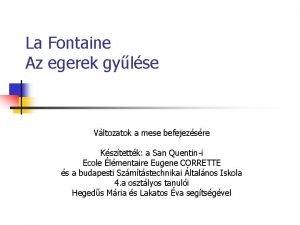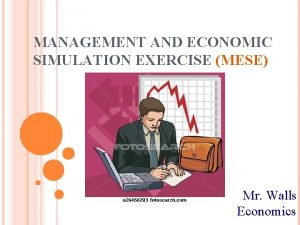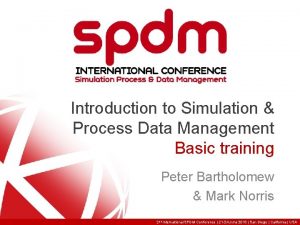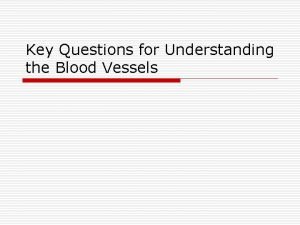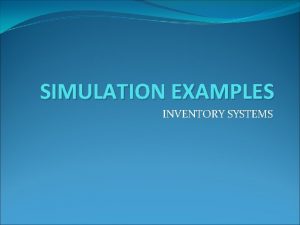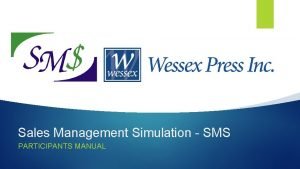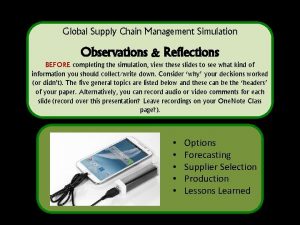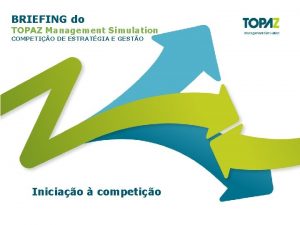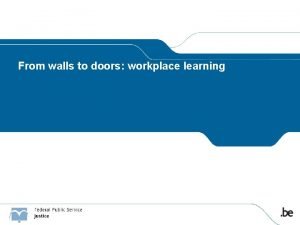MANAGEMENT AND ECONOMIC SIMULATION EXERCISE MESE Mr Walls



























- Slides: 27

MANAGEMENT AND ECONOMIC SIMULATION EXERCISE (MESE) Mr. Walls Economics

Introduction § MESE is a computer-simulated program that develops decision-making skills. Each team is set up as a company, and determines its company’s performance by virtually deciding: v Product pricing v The amount to produce v The marketing budget v Capital investment v Research and development spending § Five (5) variables to change, this is why we want 5 per team

The Product you are Producing Yes, it is an INK PEN The You-Name-It Pen

Why Ink Pens Think Bic, Cross, Paper Mate, Pilot, Write Bros. Why, Sales (MONEY)

Introduction § Teams can improve their companies’ performance by correctly analyzing: v Market trends v Your own strategies v Other teams strategies v Making correct decisions based on the information provided Ø Company Reports – Your data Ø Industry Reports - Everyone’s data Ø Summary Reports – Industry “snapshot”

ORGANIZING THE SIMULATION § Create groups of 4 or 5 people § Company formation • Company (team) name or identifier • 4 -8 characters; no ‘ , . - _, etc • Must be clean, NO innuendo § Write names of all Company members as well as team name on the two (2) white sheets of paper § Keep one (1) in folder and give one (1) to Mr. Walls

BEGINNING THE SIMULATION § Considerations in Selecting a Pricing Strategy Ø HIGH PRICE = ____________ Better Quality Higher Revenue Lower Quality Lower Revenue Ø LOW PRICE = ____________ Ø Middle of the Road = _________ Best of Both

DECISION - MAKING § STEP 1: Setting a Selling Price v _____ HIGH Price, _______ LOW volume v _____ LOW Price, _______ HIGH volume v MIDDLE OF THE ROAD v HYBRID

DECISION - MAKING § STEP 1: Setting a Selling Price Ø Price is actually a “range” of prices • High Price: $33 - $35 • Middle of the Road: $28 - $32 • Low Price: $25 - $27

DECISION - MAKING § STEP 2: Establishing a Production Level Ø Production based on price level • High Price: 75% of factory capacity • Middle of the Road: 80% of factory capacity • Low Price: 85% of factory capacity

DECISION - MAKING § STEP 2: Establishing a Production Level Ø Production based on price level & factory size o Factory Capacity = 700 • 700 X. 75 (High Price) Production • Production level this Round = 525 Units • 700 X. 80 (Middle of Road) Production • Production level this Round = 560 Units • 700 X. 85 (Low Price) Production • Production level this Round = 595 Units Ø Computer suggested numbers, YOU choose

DECISION - MAKING § STEP 3: Determining $$ Amount for Marketing Ø Allocation based on production level • High Price: 25% of previous rounds amount • Mid. of the Rd: 20% of previous rds. amount • Low Price: 15% of previous rounds amount

DECISION - MAKING § STEP 3: Determining $$ Amount for Marketing Ø Allocation based on production level and previous rounds dollar amount; ex: $1, 400 • High Price: 25% of $1, 400 = $350 • $1, 400 + $350 increase = $1, 750 this Round • Mid. of the Rd: 20% of $1, 400 = $280 • $1, 400 + $280 increase = $1, 680 this Round • Low Price: 15% of $1, 400 = $210 • $1, 400 + $210 increase = $1, 610 this Round Ø Computer suggested numbers, YOU choose

DECISION - MAKING § STEP 4: Determining $$ Amount for Capital Investment Ø Allocation based on production level • New production number X $40 (cost) PLUS • DEPRECIATION NUMBER (2 Numbers) • This equals TOTAL INVESTMENT

DECISION - MAKING § STEP 4: Determining $$ Amount for Capital Investment Ø Allocation based on production + depreciation • New production number X $40/Pen (Cost) o 525 last Rd; 560 this RD. increase of 35 o 35 X $40 = $1, 400 New Investment • DEPRECIATION ($$ Value) o Old equipment that MUST be replaced o This round = $1, 400 • ADD TWO NUMBERS $1, 400 + $1, 400 = $2, 800, This equals TOTAL INVESTMENT Ø Computer suggested numbers, YOU choose

DECISION - MAKING § STEP 5: Determining $$ Amount for Research and Development Ø Allocation based on production level • High Price: 25% of previous rounds amount • Mid. of the Rd: 20% of previous rds. amount • Low Price: 15% of previous rounds amount

DECISION - MAKING § STEP 5: Determining $$ Amount for R & D Ø Allocation based on production level and previous rounds dollar amount; ex: $525 • High Price: 25% of $525 = $131 • $525 + $131 increase = $656 this Round • Mid. of the Rd: 20% of $525 = $105 • $525 + $105 increase = $630 this Round • Low Price: 15% of $525 = $79 • $525 + $79 increase = $604 this Round Ø Computer suggested numbers, YOU choose

MESE REPORTING § The Company Report Ø Each company receives a confidential report after each period. The report consists of an: • Operations Report • Income Statement • Cash Flow • Balance Sheet

MESE REPORTING § The Industry Report Ø The Industry Report summarizes the condition of the Ink Pen industry and compares the performance of each student company. The report also notes the percentage changes from the previous period in four general areas: • Units • Dollars • Productivity • Economics

MESE REPORTING § The Summary Report Ø A Summary Report/Industry Analysis will also be available after each round. This report gives a “snapshot” view of the industry as a whole. This report is divided into five sections: • Company Decisions • Results of Company Operations • Company Factory Report • Company Financial Results • MESE Performance Index

MESE PERFORMANCE INDEX Ø The MESE Performance Index (MPI) is an alternative to Retained Earnings for determining relative performance in MESE. Ø Like Retained Earnings, MPI provides a measure of relative performance. It includes six (6) specific factors that are important in evaluating company performance. Ø All companies begin the simulation with an MPI of 100. As a company’s position in the industry improves, its MPI improves. If it declines, so to does the MPI. Ø Thus the MPI may be higher than 100, or less

MESE PERFORMANCE INDEX Ø The level of MPI is driven by the retained earnings factor. The other factors, with the exception of productivity, are relative and highlight differences between the companies. Ø The Six (6) factors that make up the MPI are: § § § Retained Earnings Demand Potential Supply Potential Productivity Market Share Growth

MANAGEMENT AND ECONOMIC SIMULATION EXERCISE (MESE) Ø Functions as the Final Exam (14% of Your Grade) Ø Group Oral Presentations on Final Exam Day Ø Can only fail if one or more of the following behaviors shown: § Corporate Espionage (cheating) § Simulation Sabotage (messing with the program or its parameters § Classroom Slackerage (grade could be reduced) § School Skipperage (individual grade reduced by a percentage based on group size)

MANAGEMENT AND ECONOMIC SIMULATION EXERCISE (MESE) Ø Read the Simulation Manual (3) copies in each folder Ø Apply What You Have Learned (Read) Ø Come See Me Before or After School for Additional Help and/or (Questions) Ø Good Luck !!

MANAGEMENT AND ECONOMIC SIMULATION EXERCISE (MESE) Ø Oral Presentation Guidelines § What strategy did your company (group) utilize § Did the strategy work as you expected § If not what changes, if any, did you make § Did the changes work out as you expected § If not, what did you do next § Did you follow any of the other companies closely as to what they were doing? Did anything that they were doing cause you to modify what you were doing § Was it easy for you to make decisions within your company

MANAGEMENT AND ECONOMIC SIMULATION EXERCISE (MESE) Ø Oral Presentation Guidelines § Did you learn anything from the first 12 Round simulation that allowed you to improve your MPI in the second 12 Round simulation § Was there anything that you which you had done differently now that you have seen the results § Overall, do you feel as though you might have learned something about the nature of business and the pressures that it faces in the real world

Revenge of the Nerds Video Apple v. I. B. M. The Creation of the Personal Computer
 I build walls
I build walls Sound word wall
Sound word wall Wass albert mese az erdőről
Wass albert mese az erdőről A vityilló
A vityilló Chiara e paolo corrono lungo una strada rettilinea
Chiara e paolo corrono lungo una strada rettilinea Egyszer volt hol nem volt mese
Egyszer volt hol nem volt mese Krumpli mese
Krumpli mese Mese solare esempio
Mese solare esempio Az egerek mese
Az egerek mese Novemberi mese
Novemberi mese Mese szerkezete
Mese szerkezete Disturbi premenopausa
Disturbi premenopausa Mr mese
Mr mese Kosztolányi dezső paulina elemzés
Kosztolányi dezső paulina elemzés Prof. meier and baldwin
Prof. meier and baldwin Economic growth vs economic development
Economic growth vs economic development Economic systems lesson 2 our economic choices
Economic systems lesson 2 our economic choices Simulation process and data management
Simulation process and data management These vessels have thicker walls and a heavier tunica media
These vessels have thicker walls and a heavier tunica media Ceiling finishing
Ceiling finishing Cell organelles study guide answer key
Cell organelles study guide answer key Soft engineering advantages and disadvantages
Soft engineering advantages and disadvantages When evaluating the floors walls and ceilings
When evaluating the floors walls and ceilings Inventory simulation excel
Inventory simulation excel Wessex sales management simulation
Wessex sales management simulation Global supply chain management simulation
Global supply chain management simulation Topaz management simulation
Topaz management simulation Topaz management simulation
Topaz management simulation








